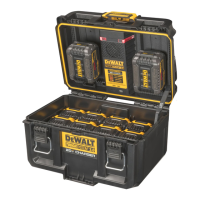ENGLISH
6
BATTERIES AND CHARGERS
The battery pack is not fully charged out of the carton.
Before using the battery pack and charger, read the
safety instructions below and then follow charging
proceduresoutlined. When ordering replacement battery
packs, be sure to include the catalog number andvoltage.
maximum (or lesser) gain approved for the transmitter by
Industry Canada. To reduce potential radio interference
to other users, the antenna type and its gain should
be so chosen that the equivalent isotropically radiated
power (e.i.r.p.) is not more than that necessary for
successfulcommunication.
• To comply with FCC and Industry Canada RF exposure
limits for general population/uncontrolled exposure, the
antenna(s) used for this transmitter must be installed
to provide a separation distance of at least 20 cm from
all persons and must not be co‑located or operated in
conjunction with any other antenna or transmitter.
The label on your tool may include the following symbols. The
symbols and their definitions are asfollows:
V ......................... volts
Hz .......................hertz
min ..................... minutes
or DC ......direct current
...................... Class I Construction
(grounded)
…/min ..............per minute
BPM .................... beats per minute
IPM ..................... impacts per minute
OPM .................... oscillations per
minute
RPM .................... revolutions per
minute
sfpm ................... surface feet per
minute
SPM .................... strokes per minute
A ......................... amperes
W ........................watts
Wh ......................watt hours
Ah ....................... amp hours
or AC ...........alternating current
or AC/DC .... alternating or direct
current
...................... Class II Construction
(double insulated)
n
o
.......................no load speed
n .........................rated speed
PSI....................... pounds per square
inch
......................earthing terminal
.....................safety alert symbol
..................... visible radiation
do not stare into
the light
..................... wear respiratory
protection
..................... wear eye protection
..................... wear hearing
protection
..................... r
ead all documentation
.....................
do not expose to rain
READ ALL INSTRUCTIONS
Important Safety Instructions for All
Battery Packs
WARNING: Read all safety warnings, instructions,
and cautionary markings for the battery pack,
charger and product. Failure to follow the
warnings and instructions may result in electric
shock, fire and/or seriousinjury.
• Do not charge or use the battery pack in explosive
atmospheres, such as in the presence of flammable
liquids, gases or dust. Inserting or removing the battery
pack from the charger may ignite the dust orfumes.
• NEVER force the battery pack into the charger. DO
NOT modify the battery pack in any way to fit into a
non‑compatible charger as battery pack may rupture
causing serious personal injury.Consult the chart at the end
of this manual for compatibility of batteries andchargers.
• Charge the battery packs only in
DeWALTchargers.
• DO NOT splash or immerse in water or otherliquids.
• DO NOT allow water or any liquid to enter batterypack.
• Do not store or use the tool and battery pack in
locations where the temperature may reach or
exceed 104°F (40°C) (such as outside sheds or metal
buildings in summer). For best life store battery packs in
a cool, drylocation.
NOTE: Do not store the battery packs in a tool with
the trigger switch locked on. Never tape the trigger
switch in the ONposition.
• Do not incinerate the battery pack even if it is severely
damaged or is completely worn out. The battery pack
can explode in a fire. Toxic fumes and materials are created
when lithium‑ion battery packs areburned.
• Do not expose a battery pack or appliance to fire or
excessive temperature. Exposure to fire or temperature
above 265°F (130°C) may causeexplosion.
• Follow all charging instructions and do not charge the
battery pack or appliance outside of the temperature
Wireless Certifications
andSafetyInformation
• This device is either CAN ICES‑3(B)/NMB‑3(B)or CAN ICES‑
5(B)/NMB‑5(B)compliant.
• This device complies with Part 15 of the FCC Rules and
Industry Canada License‑exempt RSS standard(s). Operation
is subject to the following two conditions: 1) This device may
not cause harmful interference, and 2) This device must accept
any interference received, including interference that may
cause undesiredoperation.
This equipment has been tested and found to comply
with the limits for a Class B digital device, pursuant to Part
15 of the FCC Rules. These limits are designed to provide
reasonable protection against harmful interference in a
residential installation. This equipment generates, uses and
can radiate radio frequency energy and, if not installed
and used in accordance with the instructions, may cause
harmful interference to radio communications. However,
there is no guarantee that interference will not occur in a
particular installation. If this equipment does cause harmful
interference to radio or television reception, which can be
determined by turning the equipment off and on, the user
is encouraged to try to correct the interference by one or
more of the followingmeasures: 1)Reorient or relocate the
receivingantenna, 2) Increase the separation between the
equipment andreceiver, 3) Connect the equipment into an
outlet on a circuit different from that to which the receiver
isconnected or 4) Consult the dealer or an experienced radio/
TV technician forhelp.
• Changes or modifications to this equipment not expressly
approved by the manufacturer could void the user’s
authority to operate the device.
• Under Industry Canada regulations, this radio transmitter
may only operate using an antenna of a type and

